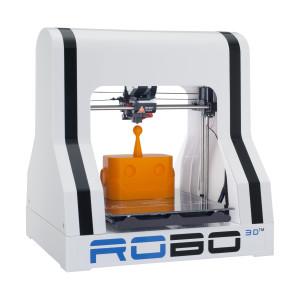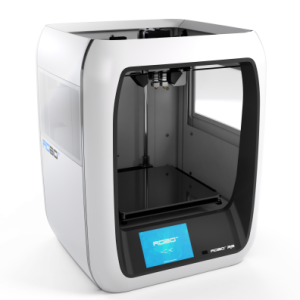![]() Robo 3D is not your average 3D printer company. They don’t just sell printers, they sell 3D printed model kits, too. Robo 3D’s first printer, the R1, was well received by consumers. The open-source 3D printer was launched through a very successful Kickstarter campaign in 2012. Like many crowd-funded, open-source 3D printers, there were some issues with the original Kickstarter units, but the R1 continued to evolve into a more reliable, robust machine.
Robo 3D is not your average 3D printer company. They don’t just sell printers, they sell 3D printed model kits, too. Robo 3D’s first printer, the R1, was well received by consumers. The open-source 3D printer was launched through a very successful Kickstarter campaign in 2012. Like many crowd-funded, open-source 3D printers, there were some issues with the original Kickstarter units, but the R1 continued to evolve into a more reliable, robust machine.
At the Inside 3D Printing Conference and Expo New York, I spoke with Robo 3D’s CEO, Braydon Moreno, about the company’s new products. Moreno explained that the company is very focused on getting their printers into schools and that they’ve been very successful doing so. He also wants to make 3D printing accessible to those new to 3D printing — so while Robo 3D offers 3D models for free download on their site, they are also bundling 3D printed kits with their printers, that come boxed up just like a traditional model kit. That’s right, you don’t have to print out the files, you’ll be able to get your feet wet with 3D printing by purchasing one of their model kits. I think this fits in well with Moreno’s vision for getting Robo 3D printers into schools and novice users’ hands. The company is also enticing consumers with their scented PLA filament, which comes in apple, blueberry, grape and strawberry flavors.
 Robo 3D’s R1 +Plus replaces the original R1 3D printer and features a heated bed with auto-leveling, has a build size of 10″ x 9″ x 8″ and can print down to 100 microns. The R1 +Plus will work with any open-source 3D printing slicing software. Robo 3D partnered with MatterHackers to design a customized version of Matter Control Software for use with the R1 that runs on Windows or Mac OS. While it may look like the original R1, this version features new linear motion and lead screws for better quality, performance and consistency. It also includes a better filament feeding system for ease of use. The new Hexagon All Metal Hot End heats up to 290°C, giving customers the ability to print in many high temp/exotic filaments.
Robo 3D’s R1 +Plus replaces the original R1 3D printer and features a heated bed with auto-leveling, has a build size of 10″ x 9″ x 8″ and can print down to 100 microns. The R1 +Plus will work with any open-source 3D printing slicing software. Robo 3D partnered with MatterHackers to design a customized version of Matter Control Software for use with the R1 that runs on Windows or Mac OS. While it may look like the original R1, this version features new linear motion and lead screws for better quality, performance and consistency. It also includes a better filament feeding system for ease of use. The new Hexagon All Metal Hot End heats up to 290°C, giving customers the ability to print in many high temp/exotic filaments.
The R1 +Plus has your 3D modeling needs covered, as it comes with a 1 year subscription to AutoDesk Fusion 360 ($4300 value) and 20 pre-installed 3D models for printing. 24/7 customer service and a 6 month parts replacement warranty will keep you up and running. In fact, if anything breaks down on the R1 +Plus during the 6 month coverage window, Robo 3D will send you the replacement part and a video showing how to install it yourself. The R1 +Plus, which was recently made available in select Staples and Best Buy locations, is currently on sale for $799.99 (R1 “The Original” Refurbished printers are available for $499.99).
Robo 3D has a couple interesting 3D printers coming down the pike. The R2 was first hinted at over a year ago at CES and has gone through some significant changes since then. The semi-enclosed R2 features a 8″ x 8″ x 8″ build volume and it can print up to 2 to 4 times faster than the Plus, at up to 300mm per second. While the R2 comes with a single extruder, it can be upgraded to a dual extruder, and I think they should seriously consider branding a dual extruder version as R2-D2 (had to do it, sorry not sorry). Artoo, I mean the R2, can print at resolutions as high as 20 microns and features a 5″ color touch screen with SD card slot, auto-leveling and wifi. It has mobile connectivity; you can print directly from your smartphone or tablet PC. Not only can the R2 print all the same filaments as the R1 +Plus (PLA, wood, bronze, carbon fiber, etc.), but it also supports using paste extruders for chocolate and food, ceramic extruders and even bio-printing extruders. The R2’s estimated sale price is $999.99.
Joining the R2 is the R2 Mini. The R2 Mini has many of the same features as its big brother but in a smaller package. It can also print at 20 microns, at up to 300mm/sec., features auto-leveling, wifi and mobile connectivity and can print in all the same materials (with the possible exception of the paste, ceramic and bio-printing extruders). The R2 Mini has a 3.5″ color screen with scroll wheel and a build volume of 5″ x 5″ x 5″. The estimated sale price for the Robo 3D R2 Mini is $599.99.
Robo 3D is a company on the rise, with a strong focus on getting their printers into schools and into the homes of the average consumer, with little or no previous 3D printing experience. It seems with Robo 3D you get a lot of printer for a low price point and the flexibility of an open-source product. I’ll be eagerly awaiting the release of the R2…hopefully the Jawas won’t get to it first.
Below is a Robo 3D promotional video and a very through “getting started” video for the Robo 3D R1 +Plus:
Subscribe to Our Email Newsletter
Stay up-to-date on all the latest news from the 3D printing industry and receive information and offers from third party vendors.
You May Also Like
Nano Dimension Expands Micro-Manufacturing with Exa 250vx 3D Printer
As it continues to push for the acquisitions of Desktop Metal and Markforged, Nano Dimension has introduced a new micro-3D printing system at Formnext. Adding to the Fabrica Tera and...
3D Systems Pushes New Tech and Partnerships at Formnext
As one of the pioneering companies in additive manufacturing (AM), 3D Systems remains a key player to watch at Formnext 2024, where it is showcasing major partnerships, innovative technologies, and...
Formnext 2024 Roundup: Pellet 3D Printing, Advanced Software, & More
Europe’s leading additive manufacturing trade show, Formenxt 2024, comes to a close today. There have been many product, material, software, and other business announcements during the event, and we’ll summarize...
Formnext 2024: Worldwide Release of Meltio Engine Blue Robotic Arm Integration Kit
Formnext 2024 is currently taking place in Frankfurt, and as you would imagine, the announcements of new machines, materials, software, and more have been flying fast and furiously into our inboxes....




































